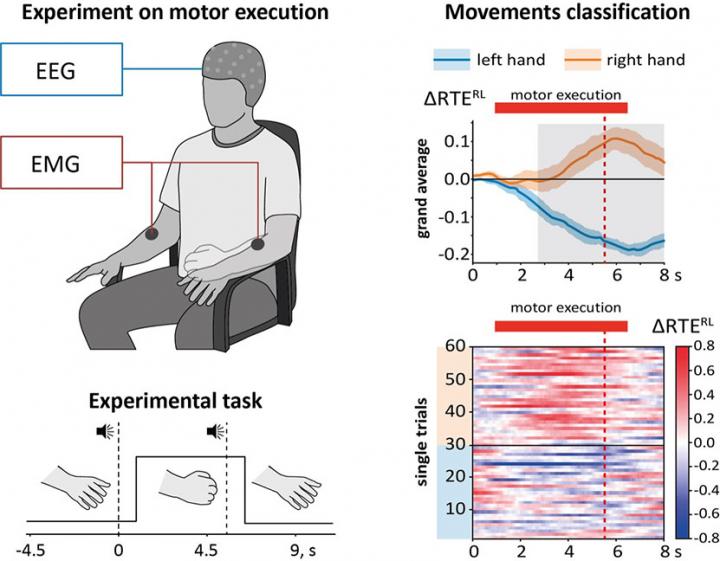By applying a nonlinear signal processing method to experimental data, researchers found a connection between motor behavior and brain activities that shows promise for brain-computer interfaces

Credit: Nikita Frolov/Innopolis University
WASHINGTON, February 4, 2020 — Motor-related brain activity, particularly its accurate detection, quantification and classification capabilities, is of great interest to researchers. They are searching for a better way to help patients with cognitive or motor impairments or to improve neurorehabilitation for patients with nervous system injuries.
There is a close relationship between motor and cognitive activity of the human brain, and suppression of the specific rhythmic activity of neurons within the sensorimotor cortex of the brain — known as the mu-rhythm (8 to 14 hertz) — is a biological marker of motor-related brain activity. Studies indicate this feature of motor-related brain activity suffers from intra- and inter-subject variability when using traditional methods to explore it, such as time-frequency analysis, spatial filtering and machine learning.
In the journal Chaos, from AIP Publishing, Nikita Frolov and colleagues at Innopolis University in Russia are approaching the problem from a different angle to search for a more robust feature of brain activity associated with accomplishing motor tasks.
“We put forward the hypothesis that suppression of mu-oscillations will cause a reduction of measured brain activity signals and, consequently, reflects the simplification of underlying neuronal dynamics,” said Frolov. “To address this issue, we applied recurrence quantification analysis, which is a powerful toolbox, to explore systems complexity through the analysis of its time series.”
The group’s work confirms, for the first time, the neuronal dynamics within the sensorimotor brain area underlying the motor functions of the human brain can be simplified.
“We demonstrated this using the RQA toolbox, which is fundamentally different from traditional methods for quantification of motor-related brain activity,” Frolov said. “We also demonstrated that RQA measures of complexity are well suited to detect and classify motor tasks.”
These results show potential for developing efficient methods for classifying brain states.
“By accurately introducing a state space, you can consider any natural system as a dynamical system. For the human brain, you can create state space by taking the measured signals of its activity as the state variables,” Frolov said.
“In our study, we consider state space formed by the set of electroencephalograms (signals of electrical activity within the brain’s cortical regions) recorded within the motor cortex. This allows us to introduce the ‘state’ of the cortical region of interest and to consider it as a dynamical system.”
One of the applications of the group’s work is “implementation of RQA-based analysis of electroencephalograms as a computational core of the brain-computer interfaces for online detection, quantification, and training of brain motor functions,” Frolov said.
“This is relevant not only for the development of closed-loop interfaces for motor skills training during neurorehabilitation but also for the diagnosis of cognitive and motor impairments as well as age-related changes.”
###
The article, “Motor execution reduces EEG signals complexity: recurrence quantification analysis study,” is authored by Elena N. Pitsik, Nikita S. Frolov, Kai Hauke Kraemer, Vadim V. Grubov, Vladimir A. Maksiemenko, Juergen Kurths and Alexander E. Hramov. The article will appear in Chaos on Feb. 4, 2020 (DOI: 10.1063/1.5136246). After that date, it can be accessed at https:/
ABOUT THE JOURNAL
Chaos is devoted to increasing the understanding of nonlinear phenomena in all areas of science and engineering and describing their manifestations in a manner comprehensible to researchers from a broad spectrum of disciplines. See https:/
Media Contact
Larry Frum
[email protected]
301-209-3090
Related Journal Article
http://dx.




